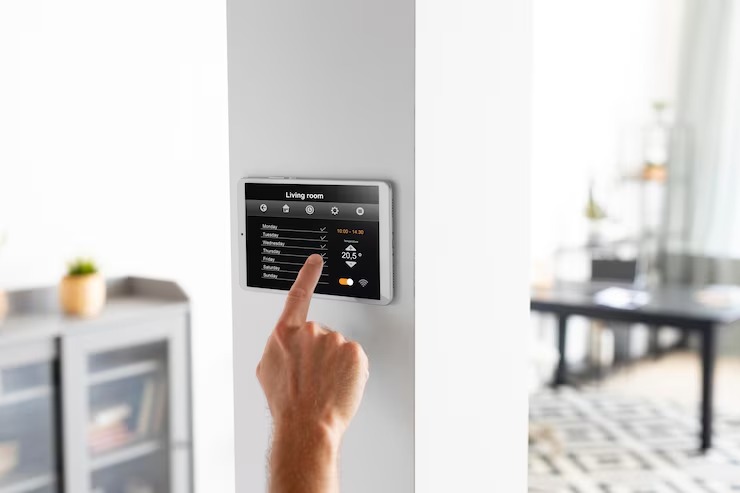What Is a Proximity Sensor? Types, Working Principle & Applications
Modern control and data-capturing models are becoming smarter each day. But they’re not just doing that by themselves; they’re aided by powerful technologies like proximity sensors. What is a proximity sensor? In simple terms, it’s a device that detects how close or far an object is, without being in physical contact. No need to press buttons or twist knobs. It just knows.
These sensors have quickly dominated literally every industry, from automotive and phones, to people counting systems. Surprisingly, many people use them daily without giving them a second thought. Here, we unveil all you need to know about proximity sensors to help you figure out how you can apply them to your business.
What Is a Proximity Sensor?
These are devices that send out a signal and then monitor it for disturbances or changes due to the presence of an object. This means they don’t need to be in contact with the object to determine their proximity. The signal in question can be anything from an infrared light, ultrasonic waves, to an electromagnetic field.
When a change or a disturbance is detected, the sensor sends an output signal (electrical) signifying the detection. Proximity signals do a lot, but the simplest is to offer a direct yes or no (1 or 0) answer, which can be used in flipping an on and off switch.

Such a clear-cut signal doesn’t need a complex system to work with, particularly if integrating it with another electronic system. All that matters is the action and reaction. For example, in a busy production line, a proximity sensor can alert the control system about an item on the conveyor and direct it to perform a specific task. It could be putting some pieces together or even start a weld.
A proximity sensor’s versatility, combined with its ability to offer real-time feedback upon detecting the absence or presence of an object, makes it vital to modern industry. It’s actually the backbone of safety and automation in self-driving cars and people counting solutions from companies like Abakus Analytics.
Why Are Proximity Sensors Important?
Now that you’ve understood “what is a proximity sensor?” – why is it so important? In our rapidly changing tech world where almost everything is gearing towards a touchless operability, proximity sensors play a vital role. They help us to interact with machines more intuitively and hygienically.
They’ve made devices to be safer, smarter, and more energy efficient. Think of proximity sensors as the sensory nerves in today’s automation world. From industrial robots stopping just shy of running into a worker, to automatic lighting that comes on when someone walks into a room—it all starts with a proximity sensor.
Also, they eliminate the need for contact, which translates to no wear and tear, therefore longer durability. Proximity sensors are the backbone of technological advancements in different sectors, from consumer products to manufacturing, making them vital in our automated world.
Types and Working Principles of Proximity Sensors?
We’ve mentioned signals like electromagnetic fields being monitored for disturbance. That’s just a basic look at it. Now let’s geek out (just a little bit). Proximity sensors use different physical mechanisms like electromagnetic induction, photoelectric effect, and capacitance change. This is what gives us all the various types of sensors, each working according to a specific principle.
Inductive Proximity Sensing
This mechanism is useful in detecting metal objects through sensing magnetic field changes. It works by generating an electromagnetic field around a coil in their sensing face. When a metal object enters this field and causes a wave disturbance, the sensor picks up on the disruption and triggers another secondary activity.
Inductive proximity is commonly used in assembly lines, ATMs, elevators, and anywhere where metal is involved and accuracy is important.
Capacitive Proximity Sensors
Their primary mode of operation is through sensing capacitance changes, and they can detect metallic and non-metallic objects, from wood, glass, plastic, and water. The sensors have a capacitor (stores charge) and an oscillator. These two working together form an electrostatic field around the working surface of the senor.
When something with a different dielectric constant (a fancy way of saying electrical behaviour) enters that field, it messes with the balance. The sensor notices this and sends a signal. Imagine rubbing a balloon on your jumper and holding it near your hair—it reacts. It’s the same principle, only neater.
Capacitive proximity sensing is used in packaging machines, fluid level detection, and even smart bins that open when you approach.
Ultrasonic Proximity Sensors
Remember how bats fly in the dark without smacking into things? That’s sonar, and ultrasonic sensors work just like that. These sensors are great for measuring distances. They primarily have a dual-role transducer that transmits and receives sound waves.
After emitting high-frequency sound waves, the sensor waits for them to bounce back from an object. By timing how long it takes for the echo to return, they calculate the distance. The same principle that allows bats to fly blindly at night without bumping into objects.
Ultrasonic proximity sensors are applicable in car parking, robot vacuums, and industrial automation.
Photoelectric Proximity Sensors
You’ll find photoelectric proximity sensors in areas where precision is highly valued and detecting small objects. The mode of operation entails emitting a ray of light which bounces back upon encountering an object.
Photoelectric sensors often have a light emitter (like an LED) and a receiver. When an object reflects or blocks the beam of light, the sensor responds to the disturbance. The sensor can either detect presence, absence, or movement depending on the behaviour of light.
Where is photoelectric proximity sensor used? You’ll find them mostly in escalator systems, conveyor belts, and even retail counters.
Magnetic Proximity Sensing
These are nifty devices that can sense the presence of a magnetic object, mainly a permanent magnet, nearby. When a magnetic field from a magnet gets close enough, it triggers the sensor. Some employ the Hall Effect tech (for detecting magnetic changes), while others use reed switches (tiny contacts that close when a magnet gets near. They’re used in door sensors, burglar alarms, and speedometers.
Real World Applications of Proximity Sensors
Now, when someone asks “what is a proximity sensor”, you’ll be able to define it, give different types and their working principles. But what are some of the real-world applications of proximity sensors?
- Smartphones: Ever noticed your screen turn off during a call when you hold the phone close to your ear? That’s a proximity sensor at work, helping save battery.
- Retail Analytics: That’s our area of expertise. Here at Abakus Analytics, we use proximity sensors to track foot traffic in our People Counting solution without invading anyone’s privacy. This solution helps retailers know when traffic is high, where they move, and what they’re attracted to.
- Healthcare: In automatic dispensers and touchless thermometers to help maintain high levels of sanitation and avoid contact-related infections.
- Manufacturing: To align equipment, sense parts, and prevent collisions.
- Home Automation: motion-activated lights, smart doors, and robot pets.
It’s an essential yet so forgotten device in most smart systems today that is used to detect how far or close an object is without making physical contact. It finds application in so many systems, from speeding up industrial workflows to self-driving cars, proximity sensors are what make anything “smart” feel effortless.
Understanding the various types and applications of proximity sensors can help you in choosing the right one for your project. Whether designing a contactless home, a smarter store, or cleaner factory, knowing how each proximity sensor works gives an edge.
Here at Abakus Analytics, we use these very proximity sensors to deliver meaningful insights into human movement without being intrusive. Our objective is not just to detect proximity, but help you make sense of it. Are you ready to see how our sensing tech can transform your business? Explore our solutions, from people counting, occupancy management, to queue management and get a free trial to see what we can do for your business.






